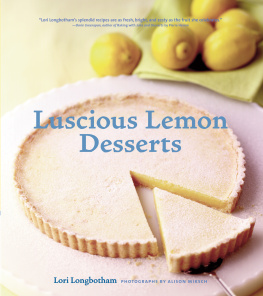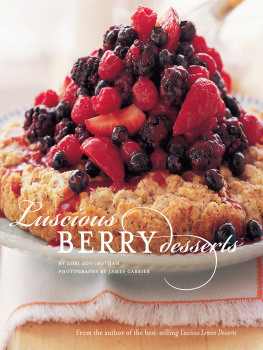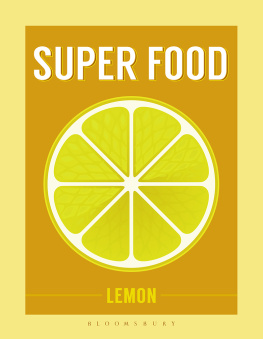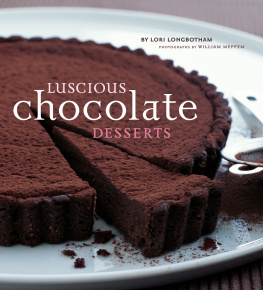
All my thanks go to my favoritesDeborah Mintcheff, Judith Sutton, Barbara Ottenhoff, Carlotta Kramer, Marie Regusis, Lisa Troland, Barbara Nell Howe, Susan Westmoreland, Rosey and Sprocket, Jean Pellegrino, Sabra Turnbull, Laura and Jessica, Dr. Bob, Auntie Jean, Mom and Ken, Steve and Liz, and Dad.
Gratitude also to the charming Bill LeBlond and the lovely Amy Treadwell for making it so easy and fun. Im grateful to Benjamin Shaykin, Alison Miksch, Sara Neumeier, and Barbara Fritz, for such a splendid-looking book. Im also much obliged to Angela Miller and Joan Ward.
Thank you, Jerry, for your endless kindness.

LEMON SWEETS ARE THE DIVAS OF DESSERTS. They sing and dance on the palate, and its not always a soft-shoe: They dance confidently, assertively, and even flamboyantlylike Rogers and Astaire on the wings of a biplane flying down to Rio.
Even a photo of plump, juicy lemons artfully arranged in a cobalt blue porcelain bowl tantalizes my appetite with visions of all the possibilities: lemon bars, lemon ice cream, lemon shortbread, lemon panna cotta, chilled lemon souffl, and lemon cheesecakes. Lemon sweets range from the simple to the sublime, from the quick and easy to the most elaborate showstoppers, from the starkly minimal to curlicue baroque. They can be as homey your mother s lemon meringue pie (or lemon lerangue, as we called it at my house); as featherlight as the crisp lemon wafers you munched on after school with a glass of cold milk; or as sophisticated as the sleek lemon tart you tasted on your first visit to Paris.
And now all your favorite lemon dessert recipes, along with some new and exciting ones (including some delightful surprises), can be found right here. Luscious Lemon Desserts, the first ever lemon dessert book, includes over seventy clearly written and thoroughly tested recipes, tons of serving suggestions, plus information on buying, storing, and using the fruit, and a handy guide to equipment and techniques.
Nothing says sunshine in the kitchen or on a menu like lemon. The lemon is a symbol of tart refreshment; its color and fragrance lift our spirits before we even taste it. We can enjoy lemon desserts all year-round, not just during a single season. Cooling in the summer, lemon desserts are perfect after a light alfresco repast under a beautiful shade tree. How about , is the perfect ending to a hearty winter feast in front of a cozy fire.
Lemons, like salt, bring out the flavors of other ingredients and make everything taste fresher and brighter. They work wonders in savory dishes, but they truly shine in desserts. Just a squeeze of juice, a paper-thin slice, or a curl of zest adds a piquant zing, a tart edge, and a lovely aroma. Lemon tastes good with almost everything. It marries with all sorts of herbs and spices, berries and other fruits, spirits and liqueurs, and even edible flowers.
I love sweet, but I love the combinations of bittersweet, sweet, and tart, and of sweet and sour even more. Lemons are born that way, to contrast and balance. Maybe thats the secret to the swooniness of lemon desserts; lemons both balance and enhance all flavors.
One of the best things about lemon desserts is how readily they take to variations. Bake some fabulous crisp lemon wafers. Nothing could be better with a bowl of sorbet and berries. But add a fresh herb like thyme or rosemary to that cookie dough, and youll have a fabulously sophisticated grown-up taste treat. Or make lemon sorbet. You can keep it pure and simple, but why not try flavoring it with a fresh herb: basil, tarragon, or lemon verbena would all be fabulous, or how about lemongrass? Herbs add a rich and complex effect, a finesse, and a fresh green flavor that strengthen and complement the flavor of lemon; but they are certainly not the cooks only option. Spices add a specific quality and dimension to a lemon dessert and may be just what a dish needs to lure the sweetness from other ingredients. Wines, liqueurs, and spirits are other quick and easy ways to add intense, interesting flavors to lemon desserts.
Every element of a lemon can be used in dessertsthe zest, pulp, and juice. The essential oils in the zest add a subtle, yet lively layering of flavors. A squeeze of juice can provide the necessary acid note to perfectly balance the flavors of a dessert, and the lemon juice and zest lift and reveal flavors, mingle with and heighten flavors, and can enhance and reveal flavors by balancing sweetness and richness.
Think of lemonade and how much better it is than plain sugar and water. Thats exactly what lemon can do for a dessert. Close your eyes and put yourself in a chair in a lovely outdoor cafe in Paris. Youre terribly thirsty after all that shopping. What should you order? Definitely the citron press, the perfect thirst quencher. Its just lemon juice and ice in a tall glass, served with a carafe of water, a small pitcher of sugar syrup, and a long spoon for a delicious and refreshing drink. As with a cold, frosty serving of ail-American lemonade, the lemon adds a good dose of sour, but one that is well masked with sweet. The acid adds clean, dry, and refreshing tones.
So, turn that notorious old sourpuss, the lemon, into the sweetest thing youve ever tasted.

Lemons are fresh, colorful, and fragrant all year-round; they know no season. They are the most versatile citrus, and the one that keeps the longest.
all about lemons
TYPES OF LEMONS There are three types of lemon: common, rough, and sweet. The tart yellow ones that most of us choose from the produce section of the local supermarket are common lemons: egg-shaped Eurekas in the summer and Lisbons in the fall. Rough lemons are used only as rootstock for other citrus. Sweet lemons are not really sweet, just less acidic. Meyer lemonsthe small, round, thin-skinned variety favored by gourmetsare considered sweet lemons, although really theyre just not sour. Look for them in specialty markets and on backyard trees, mostly in California.
HOW TO BUY LEMONS Igrewupin California with lemon trees in the backyard, and we picked lemons whenever we wanted them. I will never forget the fragrance of those lemons and their blossoms. Now that I live in New York City, where the climate is not conducive to lemon trees (and most of us dont have backyards), I do my lemon shopping at local produce markets and in supermarkets. I am happy with the lemons I buy; their superb self-packaging allows them to be shipped, handled, and stored for long periods of time and still remain very high quality.
Supermarkets offer a year-round, reasonably priced supply of lemons. Theyre always there, glowing in the produce section, piled high and bright yellow. Unlike other varieties of citrus fruit, no distinction is made by retailers between the types of lemons available, largely because most of them have similar qualities. Some lemons have very fine skin and are slightly smaller and more rounded in shape. They usually have a thinner layer of pith under the rind and are therefore more attractive when cut for garnishes or decorations. The rougher, larger, and more elongated fruit tends to have a thicker layer of pith and often more seeds.
Always choose the freshest lemons. They should have lustrous, oily skins and be smooth and firm to the touch. Avoid blemished, bruised, and dry, wrinkled specimens. The thinnerskinned lemons usually contain more juice, and those with thicker skin tend to have more flavorful zest.














